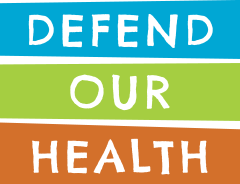Danger on the Plate
July 25, 2017 | Uncategorized |
As the anesthesia mask was placed on her baby boy’s face, Laura Seaton started singing to him, trying to keep him calm. Her eight-month-old son needed a three-and-a-half hour surgery to reconstruct his penis.
Laura’s son was born with a common birth defect. The more she has learned about it, the stronger her motivation has grown to join a growing number of parents, consumers, nurses, physicians, scientists, and health and safety advocates who are calling on the food industry to get toxic chemicals out of food.
They want The Kraft Heinz Company to lead off.
No Warning
There was no warning during her pregnancy that Laura’s baby would be born with “hypospadias with chordee.” If you haven’t heard of it, yet, that’s likely to change, because it has become one of the most common birth defects among babies in the United States. Google it, and within 30 seconds you can read stories like Laura’s.
Like many pregnant women, Laura was careful to eat a healthy diet, get regular exercise, and protect herself and her developing baby from dangers like alcohol, cigarette smoke, and chemical cleaning products.
“But I had no idea there were dangers hiding in the foods I ate,” she says. Not until she learned about the group of toxic chemicals known as phthalates (THAL-eights).
Often called “the everywhere chemical,” phthalates soften plastics and hold fragrance in products. And they’re in inks, adhesives, and coatings. They’re in furniture, cleaning products, shower curtains, cosmetics—and food.
Phthalates are hormone-disrupting chemicals that a growing body of strong scientific evidence shows harm the growing brain and reproductive health, especially during pregnancy and early childhood. They interfere with testosterone and thyroid hormones, both critical to healthy development, and are associated with birth defects like hypospadias with chordee and learning disabilities.
A developing fetus or young child with the highest exposure to phthalates may grow up struggling to succeed in school, at work, and in life. Boys may suffer birth defects associated with testicular cancer or difficulty in fathering a child.
The United States has banned six kinds of phthalates in toys and other children’s products, with five more proposed as additions to that list.
But phthalates aren’t banned in what kids and pregnant women eat.
Food is the number one source of exposure to toxic phthalates in utero and during early childhood, critical phases of a child’s development.
All along the food supply chain, phthalates may escape from plastic tubing, hoses, conveyor belts, gloves, seals and gaskets. In food packaging, phthalates may leach from plastic coatings, adhesives in boxes, inks on food labels, and sealants on metal lids and cans. They build up to the highest levels in fatty foods.
Kraft Cheeses
Laboratory testing completed early in 2017 shows that eight of nine Kraft cheeses tested contain phthalates.
Laura is asking Kraft Heinz to change that. Supporting her and other consumers in this call for change are national organizations including the Environmental Health Strategy Center that have joined together as The Coalition for Safer Food Processing & Packaging. Information about their campaign is at: KleanUpKraft.org.
Kraft Heinz, America’s biggest cheese brand by far, has a great responsibility to ensure the safety of all of its products. In response to major pressure from its consumers, the company has made changes in the past to improve product safety. In 2015, Kraft Heinz agreed to get artificial yellow dies out of its macaroni and cheese products.
The Coalition for Safer Food Processing & Packaging is calling on Kraft Heinz to eliminate sources of phthalates from all of its cheeses. It’s asking Kraft Heinz to identify where phthalates are coming from throughout its current supply chain, and end any new uses that could occur via new equipment or supplies. It wants the company to announce the results of its investigation, with an action plan that includes its timing for eliminating phthalates from all of its cheeses.
